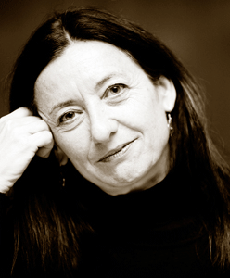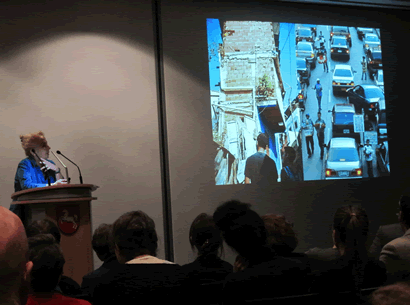
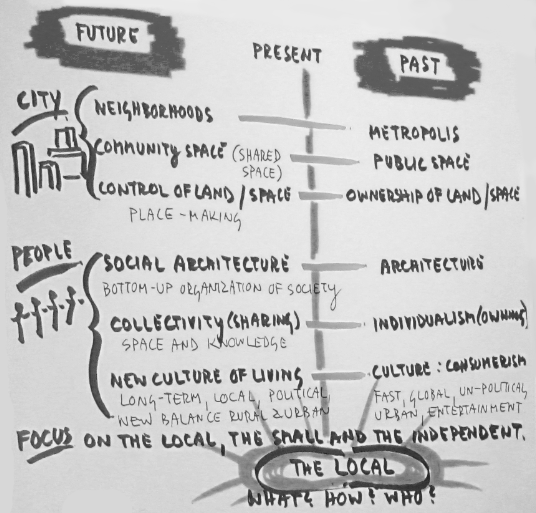
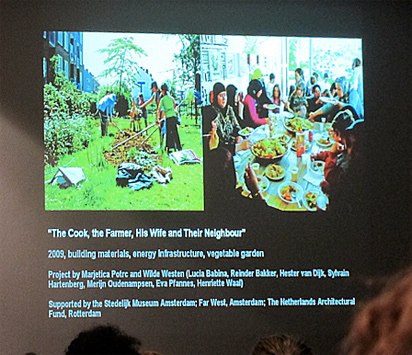
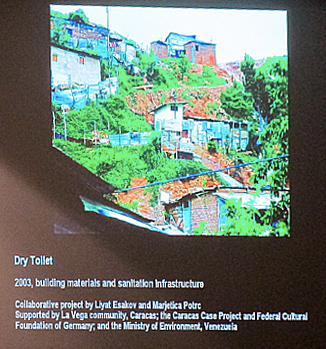
Marjetica Potrč, Presentation at the Representation of Lower Saxony in Berlin, 5th of December 2012. (Photos: Stella Veciana)
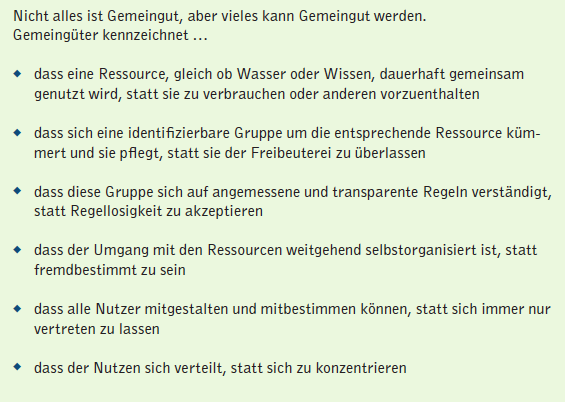
Commons - wealth by sharing. Source: "Gemeingüter - Wohlstand durch Teilen." Silke Helfrich, Rainer Kuhlen, Wolfgang Sachs, Christian Siefkes. Heinrich-Böll-Stiftung, Berlin, 2010, p. 20.
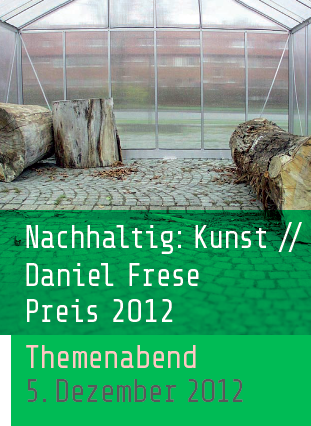
"Sustainable : Art // Daniel Frese Price 2012", at the Representation of Lower Saxony in Berlin, 5th of December 2012. In Cooperation with the Leuphana University Lüneburg, the "Kunstraum der Leuphana", "Lüneburger Innovations-Inkubator" and the support of the WBGU, BMBF year of science 2012. |
»What do Caracas and Amsterdam have in common? The artistic strategy of "commoning" in the "shared space" of the cities.«
Stella Veciana
For the final event "Sustainable : Art", within the framework of the annual program "Good news / / Sustainability viewed by art and culture", national and international artists were invited to introduce their work to the audience in order to give an insight into the "sustainability debate" in the visual arts. However, at the event itself no debate took place, but more on that at the end of the article. Marjetica Potrč (*1953, Ljubljana, Slovenia) gave the most impressive presentation of the evening. She questioned the usual notions of city and how we want to live in them. Moreover, she provided specific fields of action, where neighbours realize their visions, creatively shaping the future of the “shared space” of the city.
To focus on our preconceived ideas of the city, Potrč asked the audience what Caracas and Amsterdam have in common. And she did this not because she wanted to compare the 'Caracas barrios' with their "two-day-a-week water supply' with the 'Nieuw West' district and its "just-for-watching-greenery" (kijkgroen). What really mattered to her was introducing the audience to the "shared vision of the future" of city residents, through an analysis of their experience with on-site projects. The idea of the “urban metropolis” would shift to that of neighbourhoods, and "public space" would become "shared space". The possession of land and space should in the future be replaced by “control / usage rules”. Crucial to the townspeople would be that architecture would no longer be taken for granted in terms of “design of structures”, but as a “bottom-up organized social architecture”. Also, individual property would be replaced by shared space and knowledge. Furthermore, the “culture of consumerism” being "fast, global, un-political, urban and fun", would be replaced by a “culture of living”. This “culture of life” would be based on only long-term, local, and politically oriented approaches, as well as balancing the rural with the urban. In short, she presented a vision of the future of cities focused on the local, small and independent.
On what specific experiences does Potrč base her analysis, which has led her to this future vision of townspeople? An example is the project "The Cook, the Farmer, His Wife and Their Neighbour" ('Stedelijk Goes West', Potrč and Wild West, Amsterdam 2009). This initiative transformed a public non-walkable green space into a common scale vegetable garden, and an unused room at Lodewijk van Deysselstraat 61 into a neighbourhood kitchen. This bottom-up organization of urban landscape gave the neighbours access to and use of public property, and therefore questioned the exclusion of access (e.g. the kijkgroen) associated with the regime of private property. The project raised the question of the commons, and of the ability of user communities to define effective access and usage rules.
This vision for urban space would alter the use of public space, but more importantly, the communal planting and cooking activities would transform the coexistence and communication between neighbours, reported Potrč. In many cities, anonymous neighbours live next-doors without even recognizing each other on sight. Through this project, neighbours exchanged not only their names, but also their knowledge, which they needed in their joint project. Perhaps this very lively network of social communications relay the potential to develop the common goods? Art here becomes a tool for processes of cultural change. Potrč looks for ways to overcome the "tragedy of the commons" by helping people to develop and enforce self-organized rules for dealing with the commons. But what conditions lie behind the positive assumption that art could act as an “advocate for processes of cultural change”? What is the social field of action of the artist as a mediator?
Potrč had also gained valuable experiences in the "Dry Toilet" project (La Vega barrio, and Potrč Liyat Esakov, Caracas 2003). The "dry toilet" was installed on a hill in La Vega barrio, a district with a very low water supply. The project was supported by the Caracas Case Project, the German Federal Cultural Foundation and the Venezuelan Ministry of Environment. Public funds for development projects are necessary, but will it become a task for the arts to take care of urban infrastructure problems in developing countries?
What role can the arts play in tackling global problems such as poverty, climate change and the scarcity of resources? Which artistic practices could play a transformative role in a global context? What can the arts contribute to scientific research projects on sustainability?
The question, however, with which Potrč was often confronted, and which really surprised her was: Where is the art in this 'on-site project'? This question came particularly from visitors to the Stedelijk. The museum had supported the Amsterdam City Garden Project and invited the audience to visit it. In her article “Is This Art? The Relational Object in a Shared Space" (2010), Potrč tries to answer this question: “I want to trace public transformation from object sculpture to a “relational object” as well as the transformation from public space into shared space”. Potrč places herself in the tradition of “land art” - the idea of sculpture as an object extended to the countryside, but with the difference that in her case, the countryside is not there to be contemplated, but rather to be cultivated. The “social sculpture” of Beuys influenced her practice in that it also is an existential experience about co-existence and shared creativity embodied and enabled by art. She sees a reference to Lydia Clark's “relational objects”, in the experience of the existential self with and through the Other. Finally, she sees the idea of the ‘shared space' as developing from the desire of a community to make their environment different by creating a sustainable vision and pursuing this vision through a process of 'participatory design'. What particularly distinguishes Potrč, and which her art adds to the 'shared spaces' of cities, is the dimension of ‘Commons'. Art is challenged by her work: what would something like an aesthetics of the commons look like, and how do we want an art practice of the commons to be implemented?
In a passage of the previously mentioned article Potrč writes: "For the [art] visitor, the community garden is an art object: it is a 'relational object'. For the neighbours who use it, however, it is an element in their building of community." Like Luhmann says, each object carries a different meaning depending on within which social system it is considered (i.e. economy, law, politics, science, art), and furthermore , within one system such as the system of science, each scientific object is examined with the methods specific to a discipline and described with the appropriate technical language, giving the object a particular meaning within each research field. Some research questions relating to Potrč’s work relevant for the Research Arts, are for example: By which criteria and evaluation indicators does Potrčs’ vision for the future of cities differ from those of the expert advisors of the Federal Government? What kind of resilient practices have already been developed by active neighbourhoods in crisis situations? What could the new fields of action of a rural-urban coexistence actually look like? What additional training (science literacy) is required of the combatants of neighbourhoods?
So, how should a sustainability debate be conducted from the perspective of the arts? Coming back to the issue raised by "Sustainable : Art", the program of speakers was unfortunately so densely organized that there was no time for questions from the audience, nor for a debate on sustainability in the arts. But how can a 'relational' interest around sustainability topics be formed if there is no time for a direct exchange with the audience? Without a stimulating dialogue of inspiring views, such events usually fizzle out into nothing. The exchange was probably expected to take place at the subsequent lavish buffet. But here the inspiring ideas were scattered in many individual conversations. And the buffet, which consisted solely of meat dishes, did not correspond to what could be expected of sustainable event management. Conclusion: not only the content, the “what”, of an event matters, but also it’s process design, it’s “how”. How can a cultural event be organized sustainably? It has to be admitted though, that in the area of sustainable cultural management a lot has been tried out in the last years. Less evident is an art practice of the commons. If the art world would strengthen it’s research on the commons, it would undoubtedly provide many relevant research questions and surprising areas of action. |






